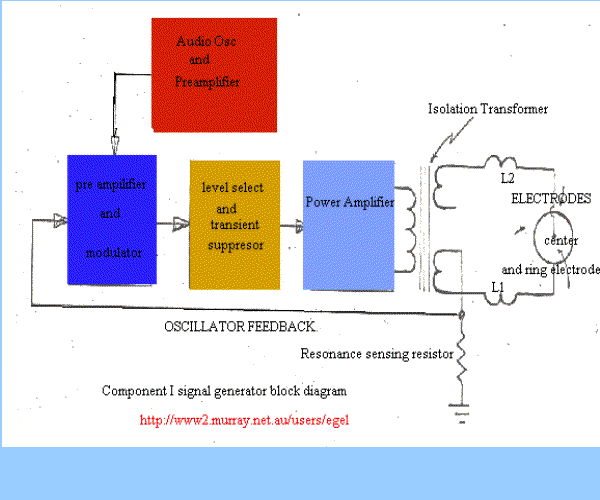
It is hardly necessary to weigh the value of the World Energy bank account for any sophisticated person ,these days
It is grim. The oil reserves will dwindle away in a score of years or so, and the coal reserves will be gone in some twelve score years (1)
This is not to say that the outlook is hopeless. There is an abundance of alternative energy sources, but the economics of development and exploitation present an enormous short term strain on the world political and banking resources.
That it will be non toxic both in its short term, and in its long term, effects. That it will be renewable in that it can be used over and over again; That it will be safe to handle, and present minimal storage and transportation problems and costs.
And finally that it will be universally available anywhere on earth.
what is this magical fuel, and why is it not being used?
It can be used in its salt water form. It can be used in its brackish form. It can be used in its snow and ice form. When such water is decomposed by electrolytic fission into hydrogen and oxygen gases- it becomes a high energy fuel with three times the energy output which is available from an equivalent weight of high grade gasoline.
[1 The interested reader should refer to the special issue of National Geographic,ENERGY,February 1981.]
Please note because I am unable to print symbols when the word triangle is mentioned in a formula it is for the symbol triangle and when the words to the power of is mentioned it is a exponent power value. (web Ed)
The answer is simple .Because it costs too much with existing technology to convert water into gases hydrogen and oxygen. The basic cycle of using water for fuel is described in the following two equations, familiar to every high school student of Chemistry:
electrolysis
HO -------- +249.68 Btu h2 + (1/2)O2 per mole of water (1)
triangle G (1 mole = 18 gms. )
This means that 302.375 Btu of energy (heat or electricity) will be released when the gases, hydrogen and oxygen, combine. The end product (the exhaust ) from this reaction is water.
Note that more energy (under ideal conditions ) is released. from combining the gases than is used to free them from water.
It is know that under ideal conditions it is possible to get some 20% more energy out of reaction (2) above, then it takes to produce the gases of reaction (1) above. Therefore ,if reaction (1) could be carried out at 100% efficiency, the release of energy from reaction (2) in an optimally efficient engine( such as a low temperature fuel cell),there would be a net energy profit which would make the use of water as a fuel an economically feasible source of energy .
The cost of producing hydrogen is directly related to the cost of producing electricity. Hydrogen as produced today is generally a by product of off- peak-hour electrical production in either nuclear or hydro electrical plants. The electricity thus produced is the cheapest way of making hydrogen. We can compare the cost of production of electricity and the cost of producing hydrogen. The following is based on federal Power commission ,and American Gas Association Figures of 1970 and on a 1973 price evaluation (just before OPEC oil price escalation.)
Relative prices in dollars per 10000000 Btu . See Appendix 1 for definition of British Thermal units (a)
@9.1 mils/kWh
COST COMPONENT ELECTRICITY ELECTROLYTICALLY
PRODUCED HYDROGEN
Production 2.67 (b) 2.95 to 3.23 (b)
Transmission 0.61 0.52 ©
Distribution 1.61 0.34
Total Cost $4.89 $3.81 to $4.09
Table 1.
if we compare only the unit cost of production of electricity vs Hydrogen from the above table:
10000000 Btu H2 $3.23---------------------- = = 1.209 ,or 20.9% higher cost ,H2
10000000 Btu El. $2.67
It must also be noted that the price of natural gas is much cheaper than either electricity or hydrogen, but because of the price fluctuations due to recent de-regulation of gas. It is not possible to present a realistic figure. In the opinion of Penner (Op. Cit.),
if the hydrogen production cost component of its total cost could be reduced three fold, it would become a viable alternate energy source.
In order to achieve such a three-fold reduction in production costs, several major breakthroughs would have to occur.
By a combination of the breakthroughs outlined above ,1),2), and 3) utilized in a highly efficient engine to do work, it is possible to achieve a 15% to 20% surplus of energy return over energy input, theoretically.
It is of interest to record that a new invention is now being developed to realise the above outlined goal of cheap, clean renewable and high grade energy.
which produces hydrogen as fuel, and oxygen as oxidant, from ordinary or from sea water, eliminating the cost and hazard of liquefaction ,storage, transmission, and distribution. The saving of this aspect of the invention alone reduces the total cost of hydrogen by about 25%. This Thermodynamic Device is based on a new discovery- The efficient electrolytic fission of water into hydrogen gas and oxygen gas by the use of low frequency alternating currents as opposed to the conventual use of direct current, or ultra-high frequency current today. Such gas production from water by electrolytic fission approaches 100% efficiency under laboratory conditions and measurements.
This Thermodynamic Device has already been tested at ambient pressures and temperatures from sea level to an altitude of 10,000 feet above sea level without any loss of its peak efficiency. The device produces two types of gas bubbles; one type of bubble contains hydrogen gas; the other type contains oxygen gas. The two gases are thereafter easily separable by passive membrane filters to yield pure hydrogen gas, and pure oxygen gas.
The separate gases are now ready to be combined in a chemical fusion with a small activation energy such as That from a catalyst or an electrical spark, and yield energy in the form of heat, or steam, or electricity- as needed .When the energy is released by the chemical fusion of hydrogen and oxygen, the exhaust product is clean water. The water exhaust can be released into nature .and then renewed in its energy content by natural processes of evaporation, solar irradiation in cloud form, an subsequent precipitation as rain on land or sea ,and then collected again as a fuel source. Or, the exhaust water can have its energy content pumped up by artificial processes such as through solar energy acting through photocells. Hence, the exhaust product is both clean and renewable. The fuel hydrogen, and the oxidant oxygen, can be used in any form of heat engine as an energy source- If economy is not an important factor. But the practical considerations of maximum efficiency dictate that a low temperature FUEL CELL with its direct chemical fusion conversion from gases to electricity offers the greatest economy and efficiency from small power plants (less than 5 kilowatts).
For large power plants ,steam and gas turbines are the ideal heat engines for economy and efficiency. With the proper engineering effort ,automobiles could be converted rather easily to use water as the main fuel source.
2 AN ELEMENTARY INTRODUCTION TO THE DESIGN AND OPERATION OF THE THERMODYNAMIC DEVICE TO ELECTROLYSE WATER WITH A.C.
The Thermodynamic Device (TD) is made up of three principal components: AN electrical function generator, Component I, that energizes a water cell, the TD ,Component II and Component III , a weak electrolyte.
COMPONENT I. The Electrical Function Generator See Fig 1.

This electronic device has a complex alternating current output consisting of an audio frequency (range 20 to 200 Hz) amplitude modulation of a carrier wave (range - 200 to 100,000 Hz)
The output is connected by two wires to Component II at the center electrode, and at the ring electrode. See fig1. The impedance of this output signal is continuously being matched to the load which is the water solution in Component II.
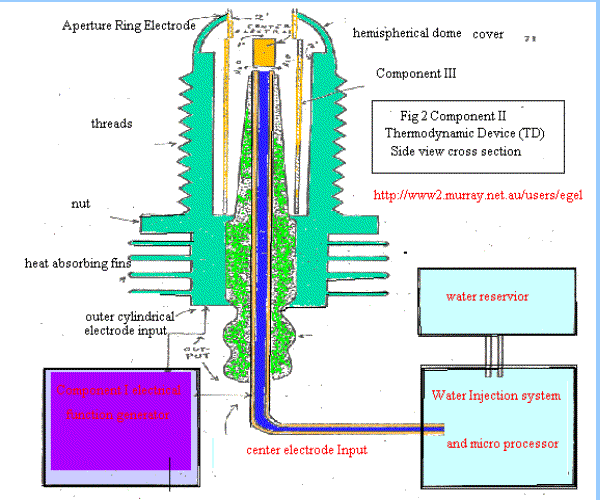
The TD is fabricated of metals and ceramic in the geometric form of a coaxial cylinder made up of a centered hollow tubular electrode which is surrounded by a larger tubular steel cylinder.
These two electrodes comprise the coaxial electrode system. energised by Component I. The space between the two electrodes is, properly speaking, Component III which contains the water solution to be electrolysed. The center hollow tubular electrode carries water into the cell, and is further separated from the outer cylindrical electrode by a porous ceramic vitreous material. The space between the two electrodes contains two lengths of tubular Pyrex glass, shown in Figures 2 and 3. the metal electrode surface in contact with the water solution are coated with a nickel alloy.
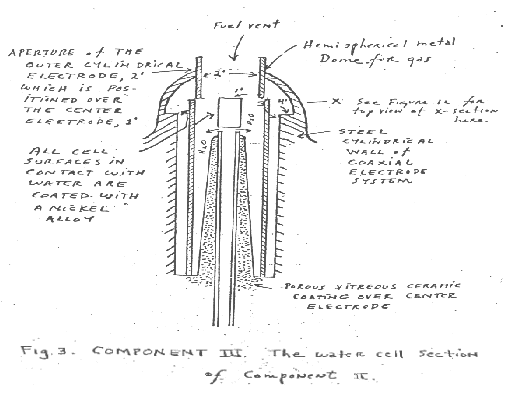
This consists of the water solution ,the two glass tubes, and the geometry of the containing wall of Component II. It is the true load for Component I, and its electrode of Component II.
The Component III water solution is more properly speaking ,ideally a 0.1540 Molal Sodium Chloride solution, and such is a weak electrolyte. In figure 4 we show the hypothetical tetrahedral structure of water molecule, probably in the form in which the complex electromagnetic waves of Component I to see it. The center of mass of this tetrahedral form is the oxygen atom. The geometric arrangement of the p electrons of oxygen probably determine the vectors I(L1) and I (L2) and I (H1) and I(H2) which in turn probably determine the tetrahedral architecture of the water molecule. The p electron configuration of oxygen is shown in figure 5 . reference to Figure 4 shows that the diagonal of the right side of the cube has at its corner terminations the positive charge hydrogen (h+) atoms; and that the left side of the cube diagonal has at its corners the lone pair electrons,(e). It is to be further noted that this diagonal pair has an orthonormal relationship.
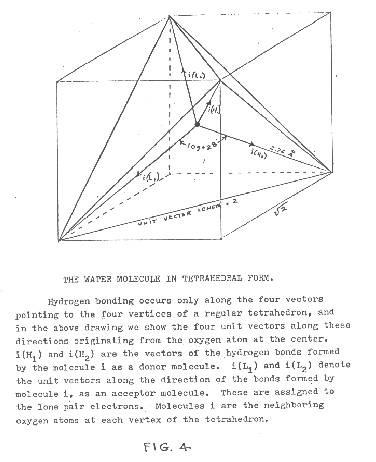
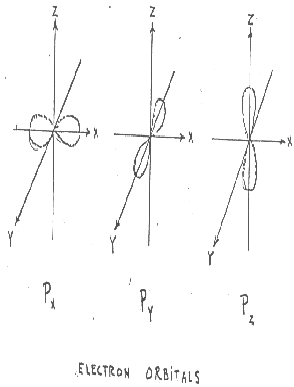
we will now portray the complex electromagnetic wave as the tetrahedral water molecule sees it. The first effect felt by the water molecule is in the protons of the vectors, I (H1) and I (H2). These protons feel the 3 second cycling of the amplitude of the carrier frequency and its associated side bands as generated by Component I. This sets up a rotation moment of the proton magnetic moment which one can clearly see on the X Y plot of an oscilloscope, as an hysteresis loop figure. However, it is noted that this hysteresis loop does not appear in the liquid water sample until all the parameters of the three components have been adjusted to the configuration which is the novel basis of this device. The hysteresis loop gives us a vivid portrayal of the nuclear magnetic relaxation cycle of the proton in water.
The next effect felt by the water molecule is the Component I carrier resonant frequency, Fo. At the peak efficiency for electrolysis the value of Fo is 600 Hz plus or minus 5 Hz.
This resonance however is achieved through control of two other factors. The first is the molal concentration of salt in the water . this is controlled by measuring the conductivity of the water through the built in current meter of Component I. There is maintained an idea ratio of current to voltage I/E =0.01870 which is an index to the optimum salt concentration of 0.1540 Molal.
The second fact/or which helps to hold the resonant which helps to hold the resonant frequency at 600 Hz is the gap distance of Y, between the centre electrode, and the ring electrode of Component II.
This gap distance will vary depending on the size scale of Component II, but again the current flow, I, is used to set it to the optimal distance when the voltage reads between 2.30 (rms) volts, at resonance Fo, and at molal concentration ,0.1540. The molal concentration of the water is thus seen to represent the electric term of the water molecule and hence its conductivity.
The amplitude modulation of the carrier gives rise to side bands in the power spectrum of the carrier frequency distribution. It is these side bands which give rise to an acoustic vibration of the liquid water, and it is believed to the tetrahedral water-molecule. The importance of the phonon effect.- The acoustic vibration of water in electrolysis was discovered in a round -about way. research work with Component I had earlier established that it could be used for the electro stimulation of hearing in humans. When the output of Component I is comprised of flat circular metal plates applied to the head of normal hearing humans, it was found that they could hear pure tones and speech. Simultaneously acoustic vibration could also be heard by an outside observer with a stethoscope placed near on of the electrodes on the skin.
